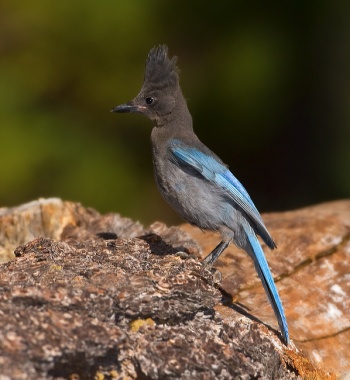- Cyanocitta stelleri
Identification
L. 29cm (11½ in); W. 43-48cm, Wt. 105gm
- Dark gray to black head and nape
- Large black crest
- The only crested jay in the west
- Most have white streaks on the forehead and chin
- Absent in some subspecies
- Body, wings, and tail are a deep blue
- Long straight bill (black)
- Black legs
Distribution
Year-round resident of mountainous regions of the western North America and Central America south to Nicaragua. Common in the Sierras, coastal ranges of California, Rocky Mountains, and coast ranges of British Columbia and southern Alaska.
Common in most of its range.
Taxonomy
Shares the Genus Cyanocitta with the Blue Jay.
Subspecies
There are 16 subspecies[1]:
Coastal
- C. s. stelleri: Southern Alaska and coastal British Columbia to north-western Oregon
- C. s. carlottae: Haida Gwaii (British Columbia)
- C. s. frontalis: Central Oregon to southern California; winters to extreme northern Baja California
- C. s. carbonacea: Coastal California (Marin and Contra Costa to Monterey counties)
Interior
- C. s. annectens: Interior British Columbia to north-eastern Oregon and north-western Wyoming
- C. s. macrolopha: Rocky Mountains (Nevada and Utah to northern Sonora)
- C. s. diademata: Sierra Madre Occidental (south-eastern Sonora to Chihuahua and Jalisco)
- C. s. philippsi: Central Mexico (San Luis Potosí, Guanajuato and Hidalgo)
Central American
- C. s. coronata: Highlands of central Mexico (San Luis Potosí to n Puebla)
- C. s. purpurea: South-western Mexico (highlands of western and central Michoacán)
- C. s. azteca: Mountains of central Mexico (México, Morelos, Puebla and west-central Veracruz)
- C. s. teotepecensis: Mountains of southern Mexico (central and southern Guerrero)
- C. s. restricta: Southern Mexico (highlands of Oaxaca)
- C. s. ridgwayi: Highlands of southern Mexico (Chiapas) to Guatemala and El Salvador
- C. s. lazula: Highlands of El Salvador
- C. s. suavis: Highlands of western Honduras to central Nicaragua
Habitat
Mixed pine/oak and coniferous forest.
Behaviour
Typical jay behavior; intelligent and inquisitive, opportunistic feeders. Will become tame around humans, especially if deliberately fed. This has led to camp-robber status in some campgrounds.
Diet
Omnivorous, will take frogs, eggs, and snakes when available. Winter diet is pine seeds, acorns and fruit; will come to feeders.
Breeding
Breeding season from March to July. Monogamous. The bulky nest is made of coarse twigs and placed 2 - 25m above the ground in the central part of a tree. Lays 2 - 6 eggs.
References
- Clements, J. F., T. S. Schulenberg, M. J. Iliff, S. M. Billerman, T. A. Fredericks, J. A. Gerbracht, D. Lepage, B. L. Sullivan, and C. L. Wood. 2021. The eBird/Clements checklist of Birds of the World: v2021. Downloaded from https://www.birds.cornell.edu/clementschecklist/download/
- Del Hoyo, J, A Elliott, and D Christie, eds. 2009. Handbook of the Birds of the World. Volume 14: Bush-shrikes to Old World Sparrows. Barcelona: Lynx Edicions. ISBN 978-8496553507
- Walker, L. E., P. Pyle, M. A. Patten, E. Greene, W. Davison, and V. R. Muehter (2020). Steller's Jay (Cyanocitta stelleri), version 1.0. In Birds of the World (P. G. Rodewald, Editor). Cornell Lab of Ornithology, Ithaca, NY, USA. https://doi.org/10.2173/bow.stejay.01
Recommended Citation
- BirdForum Opus contributors. (2025) Steller's Jay. In: BirdForum, the forum for wild birds and birding. Retrieved 11 May 2025 from https://www.birdforum.net/opus/Steller%27s_Jay
External Links
GSearch checked for 2020 platform.1






